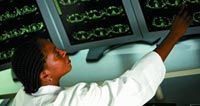Image-Based Trials: Just Another Stressful EDC Story?
It doesn't have to be, but they do require an integrated approach that stresses quality assurance.
In an image-based clinical trial, images are a subset of the overall data that is generated for a trial subject. Typically the site investigator orders images from another department that is dealing with images. This can be the radiology department of the same institution, a special imaging department (e.g., for neurology), or a remote imaging center. The subject is sent to the department or center and image data is generated with an imaging modality.

The imaging data—we exclude film data for the purpose of clarity although we know that it is still being used—is electronically available and adheres in most cases to a global and well-recognized standard for medical images called DICOM. The imaging procedure is conducted by a specially trained technician. To ensure that the image data from different patients is comparable, the configuration parameters of the imaging modality (slice thickness, contrast, etc.) must be exactly re-used for all the subjects of a trial at the given site. Those parameters differ for different vendor models.
In the typical hospital setting, most of the images are generated for clinical routine purposes. This means that an imaging procedure for a clinical trial is a rare event with a likelihood for deviations of the configuration parameters—thus impacting the comparability and quality of the image data.
For each patient visit an image data set is created that contains between one image (mammography) and hundreds of single images (magnetic resonance tomography). The size of the image sets can vary between megabytes and gigabytes. After the image acquisition, the images are stored directly on the imaging modality or in a picture archiving and communication system (PACS).
Disconnected from this process of image storage, a study nurse is periodically collecting image data for the subjects—maybe every week. This means the study nurse is searching for the patient's image data in the systems (imaging modality or PACS). This step is similar to the current EDC approach for nonimaging data, which is generated by the physician, stored in a patient record (electronic or paper), and later on extracted from the record and populated into case report forms by a study nurse.
Back to the image data. The study nurse creates a copy, stores it on portable media, fills out a data transmittal form, and ships the portable media and the form to the image recipient—an imaging CRO or sponsor. A large number of image shipments that arrive daily, are opened, checked for completeness, assigned to the specific clinical trial, and further processed. An alternative for shipping the portable media is sending the data with electronic solutions. Both approaches deliver the data to the recipient.
The recipient used to be exclusively the imaging CRO, which would process, analyze, and store the image data. The imaging CROs only passed on extracted information from the image data to the sponsor (e.g., tumor diameter, volumes) but not the image data. However, in recent years we have seen a growing request by sponsors to get the image data in addition to the extracted information.
Due to the complex nature of medical images, ensuring image quality is a challenging task. The sponsor requires data of a predefined quality level in order to use it for validating the trial hypothesis. The quality level today leaves much room for improvement. One expert stated that between 15% and 25% of the incoming images in a Phase III trial cannot be used at all.1
On the right track?
At the 2008 DIA Annual Meeting several presentations described strategies on "doing clinical trials right."2 Among the use of standards, economies of scale, and other topics, the use of EDC to bridge the health care and pharmaceutical world was also discussed. For trial data that results from clinical findings of an investigator (nonlaboratory and nonimage data) this is still a future vision because of the missing scalable business and missing organizational and technological processes.3
Comparing lab data and imaging data, there are two criteria that result in differences:
- Format. Both are originally of electronic format and both adhere to a standard.
- Comparability. Lab data in most cases is provided by central labs in a clinical trial and standardized references to varying acquisition methodologies exist to ensure comparability; image data for one trial that is generated across many sites and imaging modalities are made comparable by pretrial phantom measurements. However, more uncertainties in the image acquisition process exist that affect comparability.
In image-based trials, the quality of the image data from beginning to end is the critical factor that needs to be the center of attention. In the classical EDC approach, built-in edit checks at the point of data entry are the first steps to assuring data quality. Currently, there is no "image edit check" at the place of data entry in available technical tools. Why not? Images are the visualization of a biological response to a given signal. The response is complex and needs human expertise for assessment. The same holds true for the signal generation conditions. Current EDC vendors do not have this expertise.
On the CRO side, there are special imaging CROs that provide such expertise. They are using their own IT infrastructure (e.g., Perceptive) or are partnering with IT vendors (e.g., PhaseForward and AG MedNet) to solve the EDC task. With the current focus on fast image transfer only and not on image edit checks, quality assurance becomes a separate process at the imaging CRO. As we learned from the traditional EDC story, this is not good enough (see Figure 1).

Figure 1
A process makeover
Given this and considering the standardized environment in the imaging world described earlier, we can do better and implement processes that fit into the end user's workflow (technician, study nurse). We can provide an integrated solution and not just a copy of the old EDC approach.
In order to do so, we need to cover all process steps. This starts with the requirements in the trial protocol and ends with the image data being provided to the recipient, and includes:
- Site preparation according to protocol requirements (ideal: pushing image acquisition protocol to the modality to guarantee comparable data)
- Site qualification (same protocol for all trial subjects in a clinical routine environment)
- Image acquisition at the modality using the correct acquisition protocol
- Automatic de-identification at the site
- One-click verification by the user
- Automatic transfer of the de-identified image data to a centralized server
- Automatic quality control based on the DICOM header data
- Automatic transfer to the recipient (imaging CRO, pharmaceutical company).
In the case of image data, we find ideal prerequisites like the electronic data standardization. This could pave the way for faster adoption of an integrated approach. But there is still work needed to extend the health care–oriented standards so that they fit clinical trial and research needs. In addition, it requires a new competency that relates to defining, ensuring, and managing image quality across all process steps. Years from now we might have functions such as trial-specific imaging protocol upload to a modality, integrated basic quality checks at the scanner during the scan while the patient is still available, and direct image transfer from the scanner to an imaging CRO or sponsor for processing. All of this should be integrated in the modality software, but this can only be achieved if imaging vendors are added to the existing group of stakeholders in clinical trials.
Collaborative improvement
To get there we can start with solutions that provide the imaging sites with additional software to ensure direct data transfer of de-identified data from all existing modalities. Automatic image header data checks could give immediate feedback to the sites in case something went wrong. Those data can be transferred within several minutes after the imaging procedure to the imaging CROs and trial sponsors. Such a system enables direct engagement of the image recipients for further quality control—which cannot be done automatically currently—and image analysis. This is one step toward image-based adaptive trials. Such a system is in its piloting phase in one trial of a major pharmaceutical company, starting with a limited number of sites and growing into a network of qualified sites open to all imaging sites globally.
The current approach to discussing standardizing the interfaces of such solutions by the pharmaceutical industry is very helpful in getting the basic requirements. However, the standardization should focus on data structures—the backend standardization—and leave the appearance to the different vendors of such solutions.4 Data structure standards would also form the basis for image quality assurance steps, the image edit checks. Getting the imaging sites and the imaging industry more involved will provide for the first time an integrated direct data capture solution that might become a blue print for the overall data capture process of the future.
Gudrun Zahlmann,* PhD, is director of imaging for pharma, email: gudrun.zahlmann@siemens.com, and Markus Schmidt is project manager at Siemens Healthcare.References
References
1. Confidential information from a major pharmaceutical company.
2. S. Collins, EDC: Faster Horse or Model T? Presented at the DIA 44th Annual Meeting, Boston, 2008.
3. Zahlmann et al., "EHR–EDC Integration in Reality: Evaluating the Munich Pilot," Applied Clinical Trials, In Press.
4. "Slow Alignment of EDC, CRO Firms," ClinPage May 2008, http://www.clinpage.com/article/slow_alignment_of_edc_cro_firms/C23.
Improving Relationships and Diversifying the Site Selection Process
April 17th 2025In this episode of the Applied Clinical Trials Podcast, Liz Beatty, co-founder and chief strategy officer, Inato, discusses a number of topics around site engagement including community-based sites, the role of technology in improving site/sponsor relationships, how increased operational costs are impacting the industry, and more.
SCOPE Summit 2025: Enhancing the Patient Experience Through Site Centricity
February 12th 2025In an interview with ACT senior editor Andy Studna at SCOPE Summit, Ashley Davidson, vice president, product lead - sponsor tech strategy, Advarra, highlights the need for more site-centric approaches in study startup.
